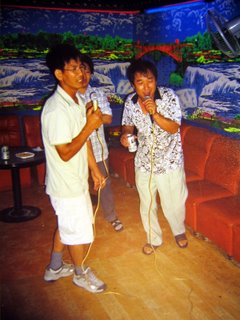Noraebang, healthy entertainment for people - in 1991
But searching further, already on February 3, 1992 Hankuk Ilbo tells that Japanese-style (waesaek) noraebangs, which first appeared in Busan in early 1991 number in hundreds and are spreading to Seoul. The article also conveys worries of excessive copying of Japanese things and, contary to the wishes of the authorities , harmful influences on the youth. And several of the articles in the list of search results are actually about government measures to control the new type of business and entertainment, added with reports of addiction and excessive following of Japanese culture. For example the president of the student association of Hanyang University, also the head of Chôndaehyôp (predecessor of Hanchongnyon), was being considered governmental honors for campaigning against Japanese-style entertaintment facilities... (Hankuk Ilbo, April 14, 1992). Funny to think that noraebang, which has been so much part of the Korean entertainment and leisure scene to make it traditional Korean people's art, became common only two years before I first went to Korea. Yi Kyu-t'ae, the highly influencial culture columnist in Chosun Ilbo who passed in February this year, saw already back then (Chosun, April 14, 1992) that the rapidly increased popularity of noraebangs was not unrelated to more traditional Korean ways of singing. • Hankyoreh21 makes a visit to the library of the deceased Yi Kyu-t'ae, which holds some 12-13000 volumes according to the estimate of his son. Update. Weekly Donga did some work back in 1999 (scroll down) to find out who brought karaoke to Korea. It was Mr Hyôn Ch'ung-dan, who kept a game room (oraksil) in front of the Donga University in Busan. He used to visit Japan often in search of new electronic leisure gadgets, and in early 1991 he brought a song accompaniment machine to Korea. He put Korean songs by himself in it, and installed the machine in his game room in April 1991. It was a glass box for 2-3 persons. Mr Hyôn was already busy at that time developing "multivision" effects, and with the release of the "Assa Panjugi" (앗싸 반주기), developed with Yeongpung Electronics, which showed lyrics in a monitor, the road for the popularity of noraebang was opened. It took one year for the noraebang boom to reach Seoul from Busan via Masan and Daegu. Update 2, June 16, 2006 G. M. Jeonuchi in the comments: I have heard (so this could be a 유언비어) that danranjujeom (단란주점) was also originally established as another "healthy" (건전한) means of entertainment, literally meaning a place where people can go and 단란하게 놀아 in a family-like atmosphere. But we all know what "단란주점" means today.You are not spreading 유언비어 - see the following article in which the word 단란주점 appears for the first time in the national newspapers in KINDS search: 술마시는 노래방」 생긴다/단란유흥주점 구분키로 Categories at del.icio.us/hunjang: music ∙ culturalhistory ∙ Koreanculture |




Comments to note "Noraebang, healthy entertainment for people - in 1991" (Comments to posts older than 14 days are moderated)
Very interesting stuff, Antti! I do recall seeing some kind of noraebangs in 1988, though. I will also look into this further; really enjoyed this piece. Thanks very much!
Roald
noraebang was first mentioned [...] as a part of government policies to encourage healthy-minded entertainment establishments that conform to the national sentiments (kungmin chôngsô) and social realities (sahoe hyônsil) instead of extravagant and irrational spending and leisure.
I have heard (so this could be a 유언비어) that danranjujeom (단란주점) was also originally established as another "healthy" (건전한) means of entertainment, literally meaning a place where people can go and 단란하게 놀아 in a family-like atmosphere. But we all know what "단란주점" means today.
Similarly, many 노래방's have also mutated into 퇴폐업소's nowadays. Even in Korea Town's in the U.S., there are 노래방's, and there are "여자 나오는" 노래방's.
I have also noticed that solo singing is more promoted in Korean cultures than western cultures. People standing up and singing solo is a common occurrence in Korea, but in the latter, I have observed people singing together in groups even if placed in a 노래방-like environment where there are only one or two microphones. I am curious if there are any studies that explore differences in preference for 독창 and 합창.
Write a Comment